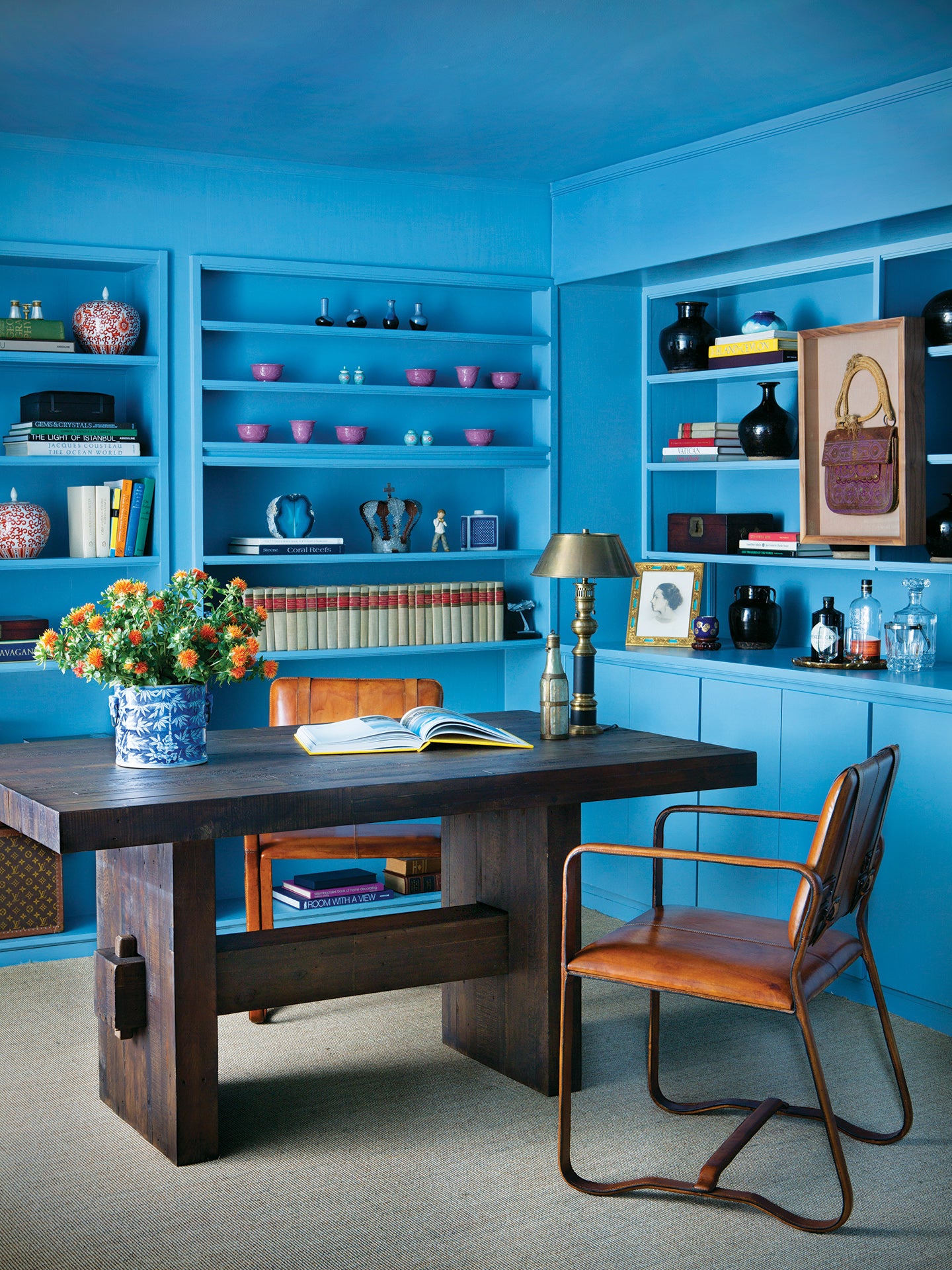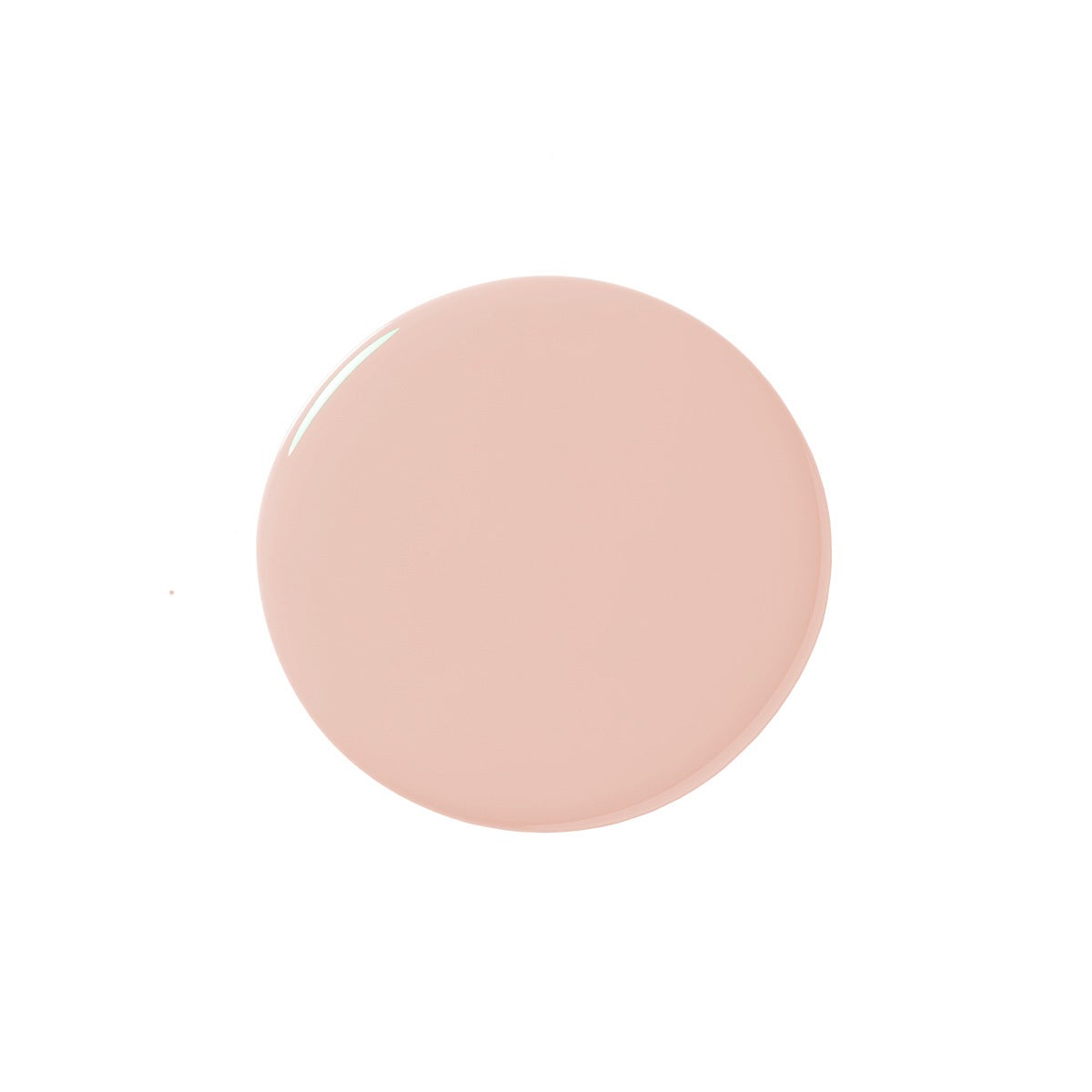If you have a decently-sized DIY project planned—refinishing your backyard fence, changing the color of your bedroom walls or front door, even giving your rental’s kitchen cabinets a makeover—you may be feeling swayed by more than one viral (i.e. satisfying) TikTok video revealing how easy a paint sprayer can make any paint job look.
But before running to your local hardware store and picking up the first one you see, Zach Kenney, professional contractor and president of Rhode Island’s ZK Painting, stresses that it’s important to know which type your project calls for and how to safely operate it. On a scale of DIY to professional, using a paint sprayer is pretty advanced. That’s why he walked us through everything you need to know, from the differences between airless and High Volume Low Pressure (HVLP) options to picking out the right tip size, so you’re able to purchase the best paint sprayer based on your needs. If you’re willing to put in the work to learn proper prep and maintenance, you’ll reap the rewards in the long run when it comes to all of your future painting needs.
Our Favorites
- Best HVLP: Wagner Control Spray HVLP Paint Sprayer
- Best Spray Gun: Husky Gravity Feed Spray Gun
- Best Pump Airless: Graco Magnum Project Painter Plus Paint Sprayer
- Best Handheld Airless: Graco TrueCoat 360DS Paint Sprayer
Best HVLP: Wagner Control Spray HVLP Paint Sprayer
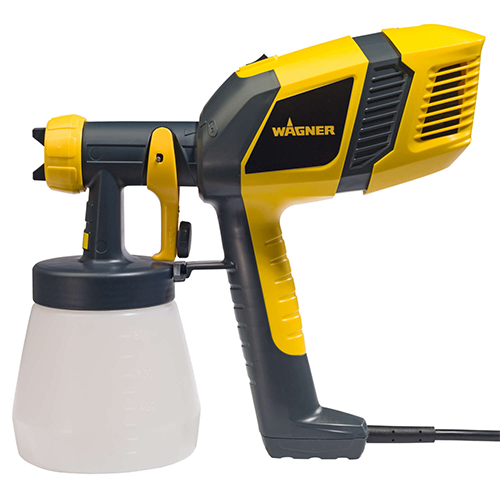
Type: Handheld | Flow Rate: 0.38 gallons per minute | Adjustable Tip: No | Max PSI: 4
What we like:
- Less than $100
- Great control, easy to use
- Compatible with paint (latex and oil) and stain
- Adjustable spray pattern (horizontal, vertical, or round)
Worth noting:
- Limited by cord length
Why we chose it: Painting furniture, trim, or even a fence? This handheld sprayer cuts back on time (three times faster than a brush) and clean-up.
With this handheld unit that promises to do it all—it can spray everything from stains and sealers to varnishes, in addition to paint—you can go from reviving an old piece of furniture to refinishing your backyard fence in time to host a summer soirée just like that. If you’re a beginner looking to dip your toes into the paint spraying world, this easy-to-control, yet powerful unit is a great place to start. It comes with two different sized cups (1 quart and 1.5 quarts). The only adjustments you have to worry about are the spray pattern and flow of the paint from ½-inch to 9-inch wide patterns.
Best Spray Gun: Husky Gravity Feed Spray Gun
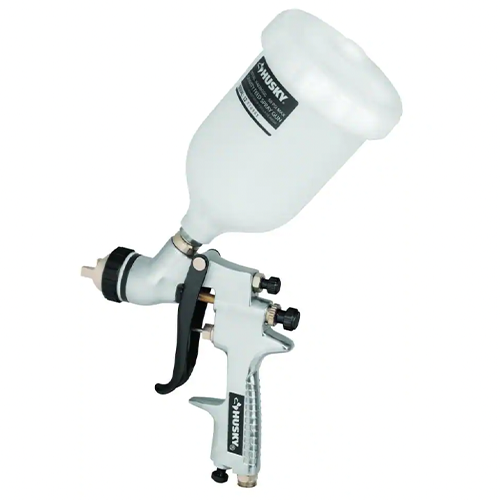
Type: Hose and pump | Flow Rate: N/A | Adjustable Tip: Yes | Max PSI: 40
What we like:
- Stainless steel needles
- Smooth trigger pull
- Comes with two different tip sizes
Worth noting:
- Can’t use latex paint
- Hose not included
Why we chose it: Sarah Sherman Samuel’s go-to tool for painting cabinets.
While you’ll need an electric air compressor to pair up with this spray gun, designer Sarah Sherman Samuel has shared that it’s more than worth it—she’s used this combo to transform multiple cabinet fronts, making IKEA and Semihandmade look custom. While it can be tempting to get a job done all in one go, considering this paint gun offers a spray pattern range from 1.2 to 9.2 inches, her tip is to stick to multiple light coats. But that just means it’s versatile enough to tackle all sorts of DIY projects. If you’re not ready to pull the trigger, you can always give her other paint hack a try: if you buy a specific type of Sherwin-Williams paint, they’ll put it in a spray can for you at the store.
Best Pump Airless: Graco Magnum Project Painter Plus Paint Sprayer
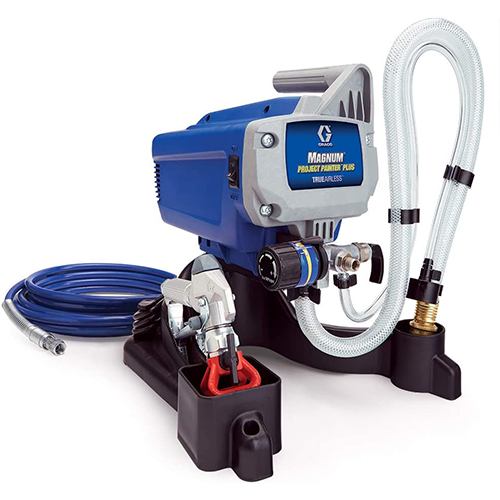
Type; Pump and hose | Flow Rate: .24 gallons per minute | Adjustable Tip: Yes (max 1.5 inches) | Max PSI: 2800
What we like:
- Lightweight (15 pounds)
- Flexible suction tube
- Spray directly from your paint bucket (no need to thin)
- Comes with a 50-foot-long hose
Worth noting:
- 1 year limited warranty
- Priciest on the list
Why we chose it: Trusted by the professionals, invest in this machine if your paint jobs tally up to about 50 gallons every year.
Kenney loves Graco, and this unit is designed specifically with the advanced DIYer in mind; it’s one of the most powerful airless units you can safely operate. And while the cost may not be worth it for those with just a single, smaller job, it will more than pay for itself if you happen to find yourself painting frequently. (Flipping furniture left at the curb? Changing the color of your door or walls every season? This is it.) Since it has such a high PSI, you don’t have to worry about getting your paint to the right thickness, you can simply plop it in the bucket directly and get started. Then, when you’re done, clean-up is as simple as attaching your garden hose up to it directly to flush all the paint out.
Best Handheld Airless: Graco TrueCoat 360DS Paint Sprayer
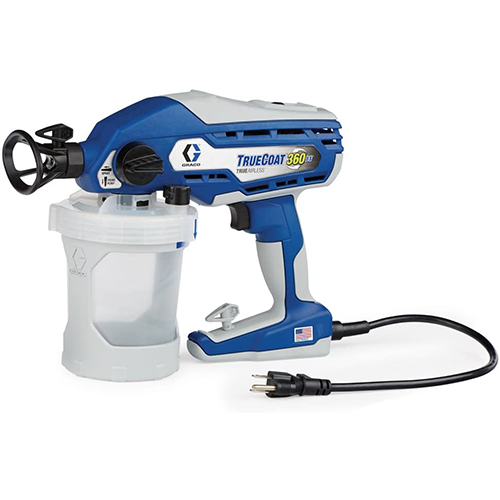
Type: Handheld | Flow Rate: .2 gallons per minute | Adjustable Tip: Yes (max 1.5 inches) | Max PSI: 1500
What we like:
- Adjustable speeds
- Stainless steel pump and nozzle
- Two reversible spray tips (for easy cleaning and unclogging)
- Ability to spray in any direction, even upside down
Worth noting:
- Short, 18-inch cord
Why we chose it: A less intimidating airless unit, this is great for those hard to reach nooks and crannies.
For smaller, home improvement projects, this handheld Graco unit is all you need to achieve fast, professional-level results. And sometimes, you might only need to do one pass, depending on whether you go with the 12-inch or 4-inch wide tip. But what we really love about this handheld sprayer is that you can flip it around in any direction, even turn it upside down, and not interfere with the finish, which makes it great for areas that are difficult to cover in one pass. And if you’re worried about too much paint coming out, just adjust down to a lower speed for greater control. The only caveat: some reviewers have noted this machine having issues later down the road, so if you encounter any problems, reach out to Graco’s customer service (which is top-notch) right away.
Seasonal Color (S)watch
How We Chose These Products
Our list of the best paint sprayers was narrowed down to those that professional painter Zach Kenney gave the DIY stamp of approval to. His favorite brands include Wagner and Graco, but we couldn’t help but include a recommendation from the DIY pro herself, Sarah Sherman Samuel, who’s definitely known to hack a paint job or two. After laying out the most important features of a paint sprayer (tip size, flow rate, and type), we made sure our picks were versatile enough to tackle a range of interior and outdoor projects, so you can take on more than a single job.
Our Shopping Checklist
Types of Paint Sprayers
For the DIYer, the two tools to be familiar with are airless and HVLP (while there are air-assisted airless options, those are probably best left to the professionals). And the first question you should ask yourself is: why am I spraying? “Most homeowners are going to spray because it’s faster than rolling,” Kenney says. “But the other group of people are going to spray because it’s a smoother finish. Is it for speed or aesthetics?”
If it’s the latter, such as reviving a piece of furniture that’s a little worse for the wear, an HVLP will be great. HVLP stands for High Volume Low Pressure—in other words, it emits a lot of air at a super low pressure. An HVLP is separated into two chambers; one is for paint and the other for air, which anatomizes the coating to get that super-smooth, quality finish. You’re also less likely to waste paint, since it’s easier to control.
If you’re going to be spraying more than a gallon, you’ll want an airless sprayer. An airless paint sprayer sprays paint at a very high pressure, such as 1,500 to 3,000 PSI. “It’s the pressure of paint through a tiny hole that makes it anatomize,” explains Kennney. “So it puts out a lot more paint at a much faster rate.” That’s why airlines models often suffer from overspray, or paint that’s lost because it’s not applied to the targeted surface, which makes it better for larger projects.
Tip Size
With an airless paint sprayer, you’ll need to select the right tip size, which is designated by a numbered code, usually three digits. “The first number is the fan width pattern, which is twice the number, and the second tells you the orifice size,” offers Kenney. “So if the tip number is 3.12, it’s a 6-inch wide pattern with a 12 millimeter orifice.”
The orifice is the size of the hole paint goes through, highlighting how much fluid will leave at a time. This aspect of airless sprayers comes in handy if you’re using a primer, typically thicker than paint, first, and you’ll want a larger orifice. According to Graco, you’ll want a tip size between .013 or .015 for oil-based paint, whereas for latex paint you’ll want to aim between .015 and .019.
Prep and Ssfety
Before turning your paint sprayer on, you’ll want to mask every surface around—seriously. Kenney has heard horror stories of other fellow painters working on a windy day, and the overspray being blown all down the street of a house they were working on, damaging multiple vehicles and siding. And with a super high PSI of an airless sprayer, it’s possible for the paint to be injected into your skin (sorry, it’s important to know!). “Protect your environment and yourself well—respirators and gloves,” he stresses. Of course, when it comes to masking, you may be spending just as much time as it would take to bust out a brush or roller. That’s why Kenney advises getting a tape machine or pre-taped plastic.
Ask Domino
Q: Is there an optimal operating temperature for a paint sprayer?
“70 degrees is good,” offers Kenney. “Cold paint gets thick and harder to spray.” Anything higher or lower can impact the paint’s viscosity.
Q: Any tips on how to get a smooth finish?
“Practice makes perfect,” says Kenney. “Youtube is your best friend. The Idaho Painter has a number of great videos about spraying. Always test out your sprayer on a sample surface you don’t care about.”
Other than that, he adds, try going light first then heavy, and always make sure the paint is continuously flowing rather than pointing at the surface from the start (this can cause the paint to pool up). And, whenever possible, move from top to bottom. If you’re using a handheld sprayer, make sure to squeeze your cup or bag to remove any air before getting started.
Q: I want to refresh my backyard fence. Can I put wood stain in my paint sprayer?
In most cases, yes! Confirm with the manufacturer what type of liquids your chosen sprayer is compatible with (are you using an oil- or water-based formula?), but nearly all of the options on our list can spray a stain, no problem.
The Last Word
Whether you’re painting a garage door or an old patio furniture set, the best paint sprayers can make quick work out of a labor-intense DIY project. If you’re tired of using a roller or having to finesse a brush around hard-to-reach corners, then it might be time to learn how to properly operate a paint sprayer—but fair warning, you may just want to repaint everything.
Domino’s editors independently curate every product on our site, because we’re just as obsessed with a great deal and an under-the-radar discovery as you are. Items you purchase may earn us an affiliate commission.
The post The Best Paint Sprayers for DIYers, According to a Professional Contractor appeared first on domino.

